Heidelberg Castle
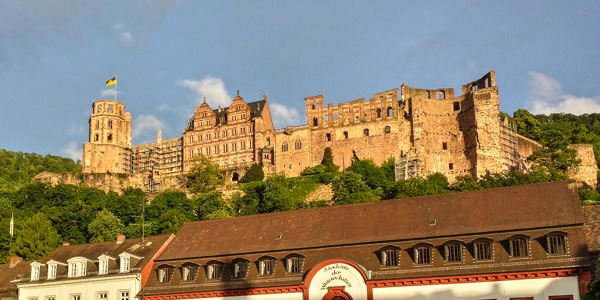
Heidelberg Castle. (Photo by Norman Z)
Germany's Schloss Heidelberg is a Romantically crumbling castle on the hill above town, offering a fascinating glimpse into castle architecture from the 13th through 16th centuries
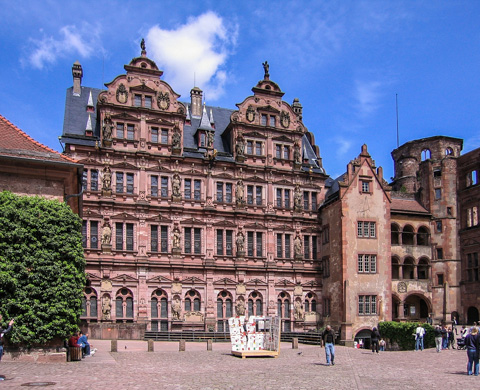
The 16th-century Renaissance Friedrichsbau at Heidelberg Castle. (Photo by Sir Gawain)
Rambling across a forested hill above the city of Heidelberg, this massive conglomerate Schloss is a testament to how these castles were often cobbled together and extended over the course of centuries—and to how quickly they could decay in the destruction of war and shifting fortunes of politics.
This elongated castle on the forested slopes of the Königstuhl 260 feet above Heidelberg, was started in the 13th century when Duke Ludwig of Bavaria was elevated to Count Palatine and thus the Wittelsbach family became Electors of the Holy Roman Empire (a title they held, impressively, until 1918).
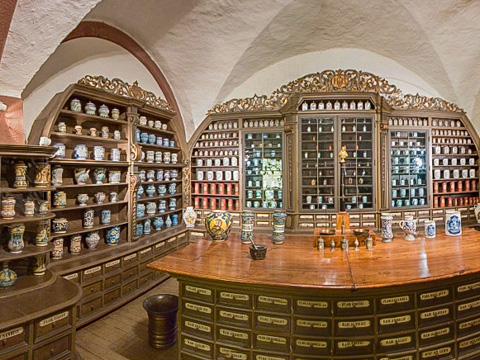
The German Apothecary Museum at Heidelberg Castle. (Photo by A. Kneisel)
It was the family's official seat for centuries, a defensive string of walls above a town renowned for its university.
As military necessity turned to princely prerogatives in the 16th century, the castle courtyards began getting filled in by palatial Renaissance structures—several of them now reduced to merely the facades.
(You can only see the interiors if you take one of the recommended guided tours—except the 16th century Ottheinrichsbau, which now houses the Deutsches Apotheken Museum, the world's largest collection devoted to the pharmacological arts, with more than 20,000 objects to make you really, really glad you didn't have to endure medical care prior to the 20th century; Deutsches-apotheken-museum.de.)
—Mark Twain, A Tramp Abroad (1880)
By the 17th century, the ravages of the Thirty Years War (Germany's disastrous Catholic-Protestant civil war, which was also Europe's first real World War, as it involved more than a dozen kingdoms and nations) and later territorial battles with the French had battered the Schloss—and Heidelberg's prominence.
Charles III Phillip (Karl Phillip) of the family's Catholic branch inherited the Electorship and took it with them to Mannheim in 1720, leaving behind only his court jester, the Tyrolean dwarf known as Perkeo of Heidelberg, to guard the wine cellars.
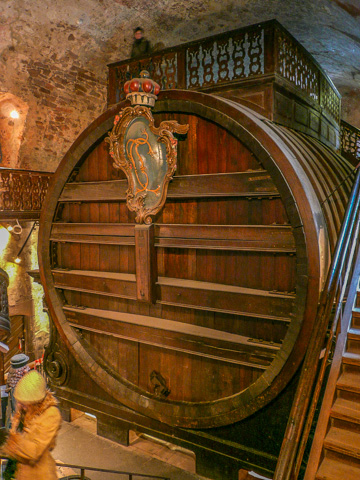
The Heidelberg Tun wine barrel.
One of Heidelberg Castle's most famous sights remains Perkeo's main charge, the Heidelberg Tun, the world's largest wine barrel, 7m x 8.5m (23x28 feet) with a capacity of 221,726 liters (58,574 gallons U.S.)—so big it even has a dance floor on the top.
Its fame made it a literary bit player in many 19th century novels, appearing in cameos or as references in works by Jules Verne, Mark Twain, and Washington Irving—it even shows up in Victor Hugo's Les Miserábles and Herman Melville's Moby Dick.
After the departure of the Palatinate Court in 1720—Charles III derisively declared upon leaving Heidelberg that "grass can grow in its streets"—Heidelberg became a relative backwater.
Its castle was left to slip into obscurity and decay—especially after 1764, when lightning struck it (again) and many parts caught fire. (Another bolt back in 1537 had already taken out the upper castle.)
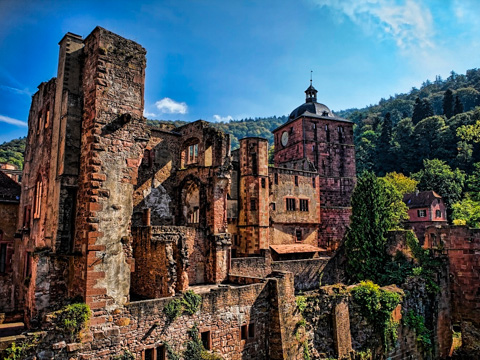
Ruins at Heidelberg Castle. (Photo by Michael Theis)
We have the 19th century Romantics to thank for Heidelberg Castle's fame. They discovered in its weedy ruins and half-finished gardens echoes of ancient glamor and strength, and all sorts of metaphors for a glorious vanished era of an idealized Middle Ages.
Legends accrued, poets arrived, and Heidelberg Castle became famous once more.
The ruins are impressive, and well worth spending a few hours poking around, using the crumbling walls and Renaissance palaces as a backdrop for Romantic stories of your own imagination—heroes and villains, secret trysts and bloody betrayals, chivalric deeds and political backstabbing (which, in the Middle Ages, was not just a metaphor but a reality).
Tips & links
Schloss Heidelberg
Neuse Schlossstrasse, Heidelberg
Tel. +49-(0)6221-658-880
Schloss-heidelberg.de
Open daily 8am–6pm (interiors open only on guided tours)
Tours in English: Apr-Oct: Mon-Fri hourly 11:15am–4:15pm; Sat-Sun 10:15am–4:15pm; Nov-Mar: Mon-Fri at 11:15am, 12:15, 2:15, and 4:15pm, Sat-Sun hourly 11:15am–4:15pm
Tours in German: Same schedule, only departing on hour rather than the :15.
Adm
Transport: Bus 757 or 30 (Vrn.de). Or ride the Bergbahn funicular from Kornmarkt in the Altstadt up to the first stop: Schloss (Bergbahn-heidelberg.de).
Plan on at least 90 minutes to two hours to explore it all.
- Heidelberg tourist info:
- Heidelberg-tourismus.de
- Baden-Württemberg tourist info:
- Tourism-bw.com
- Germany.travel
- Stuttgart-tourist.de
- Blackforest-tourism.com
- Heidelberg-tourismus.de
- Bodensee.eu
- Oberschwaben-tourismus.de
- Konstanz-tourismus.de
- Tourismus.ulm.de
- Baden-baden.com
- Activities & tours:
- Viator.com
- ContextTravel.com
- Intrepidtravel.com
- Gadventures.com
- Infohub.com
- City-Discovery.com
- Localguiding.com
TRANSPORT
- Airfares:
- Momondo.com
- AutoEurope.com
- Vayama.com
- CheapOair.com
- Cheapflights.com
- DoHop.com
- CheapTickets.com
- Priceline.com
- Airports:
- Stuttgart-airport.com, Fly-away.de (Lake Constance); Other airports within 200km: Frankfurt-airport.com, Euroairport.com (Basel), Munich-Airport.com, Zurich-airport.com
- Car/RV rentals:
- Autoeurope.com
- Momondo.com
- RentalCars.com
- CheapOair.com
- AutoSlash.com
- Trains:
- Bahn.de
- Raileurope.com
- Seat61.com
- Apartments & villas:
- Vrbo.com
- Booking.com
- Venere.com
- Rentalo.com
- Homeaway.com
- Belvilla.com
- Interhomeusa.com
- Airbnb.com
- Villasintl.com
- Craigslist.org
- Hostels & campgrounds:
- Hostelworld.com
- Gomio.com
- Hostelbookers.com
- HostelsClub.com
- Hostelz.com
- Booking.com
- Venere.com
- Agriturismo (farm stays):
- Landtourismus.de
- Bauernhofurlaub.de
- Booking.com
Related Articles |
|
This article was by Reid Bramblett and last updated in July 2014.
All information was accurate at the time.
Copyright © 1998–2013 by Reid Bramblett. Author: Reid Bramblett.
Neuse Schlossstrasse, Heidelberg
Tel. +49-(0)6221-658-880
Schloss-heidelberg.de
Open daily 8am–6pm (interiors open only on guided tours)
Adm
Tours in English: Apr-Oct: Mon-Fri hourly 11:15am–4:15pm; Sat-Sun 10:15am–4:15pm; Nov-Mar: Mon-Fri at 11:15am, 12:15, 2:15, and 4:15pm, Sat-Sun hourly 11:15am–4:15pm
Tours in German: Same schedule, only departing on hour.
Transport: Bus 757 or 30 (Vrn.de). Or ride the Bergbahn funicular from Kornmarkt up to the first stop: Schloss (Bergbahn-heidelberg.de).
